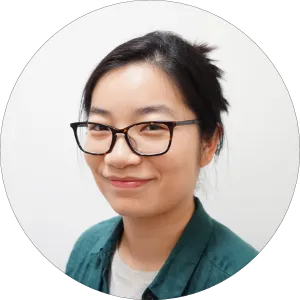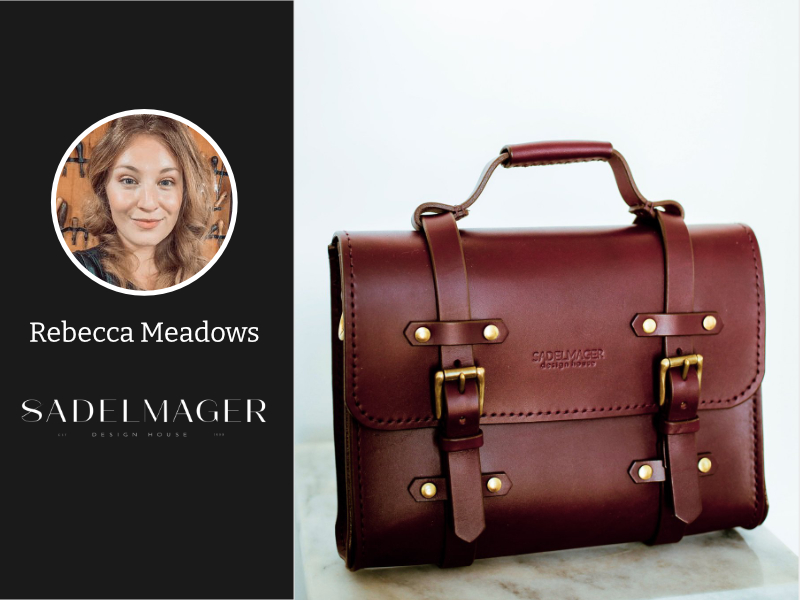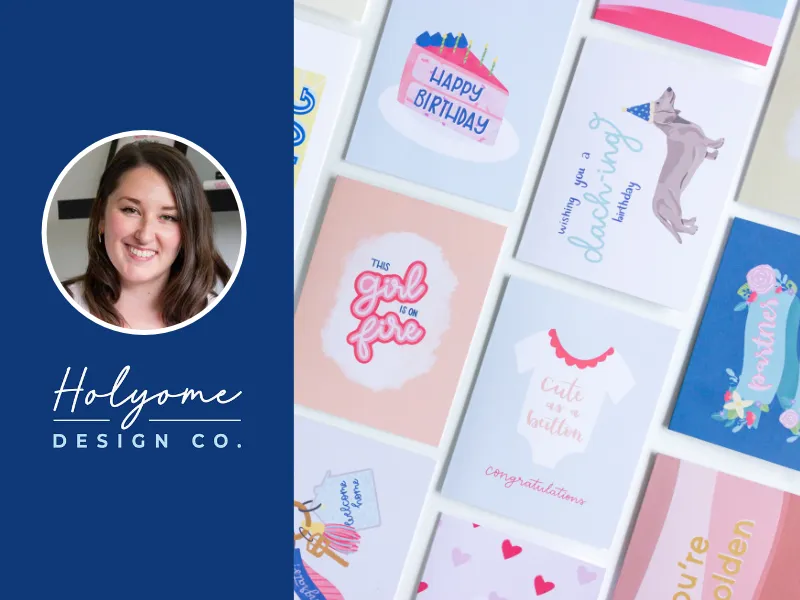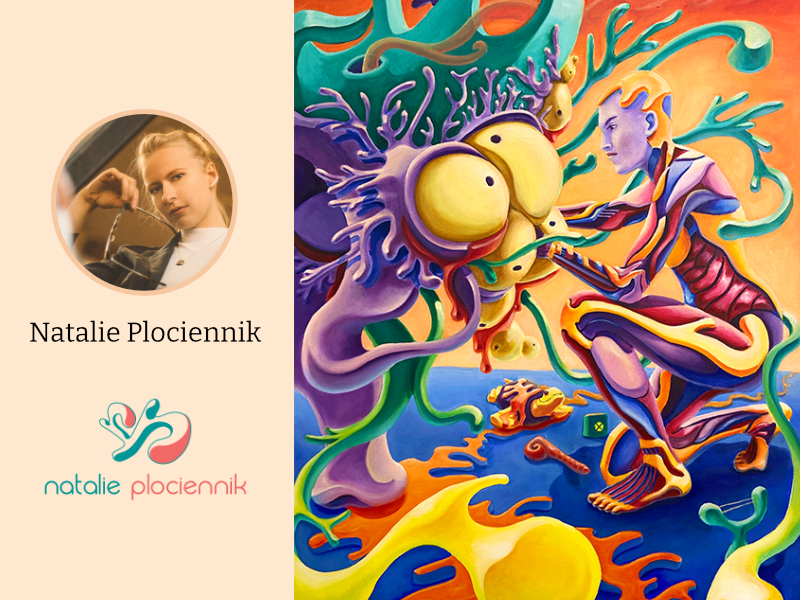
Founder Stories is a series that features creative entrepreneurs who run product-based businesses. The conversations will explore their story, their business, and show the little, hidden moments that happen behind the scenes.
Natalie Plociennik is a Toronto based artist who uses automatic drawing to embrace originality, authenticity, and imagination. I knew Natalie when we were both undergraduates at McMaster University studying sciences. Several years later, I met her again in Toronto at a local market fair. I was surprised to discover her transition into arts because I had a similar one into design. This year, Natalie is putting more effort into building the business side of her practice. We get a rare glimpse into the early stages of an art business. I was very impressed when I saw Natalie the second time at a different market. She already introduced two different products (stickers and colouring book) based on customer feedback from her previous markets. Natalie is moving fast and through each iteration of her products, she is seeking to understand how she can give her customers value while creating a sustainable practice.
Natalie's website
Natalie's Instagram
If you prefer to listen or watch this interview, you can watch it below .
Could you please introduce yourself?
Hey, Jane, thanks for having me. I'm Natalie, I am an artist. The way I would describe my work is: surreal expressions of human experiences and experiments with perception. I've been practising for four years in Toronto. Just recently, I have started a business selling my work and learning about those different processes. Up until this point, it has mostly been my creative development and my personal development that has been essential to creating an artistic practice. You can't have the business without the product, the creative work. It's been very important that it's authentic and original to me. So that has been my journey for the past four years.
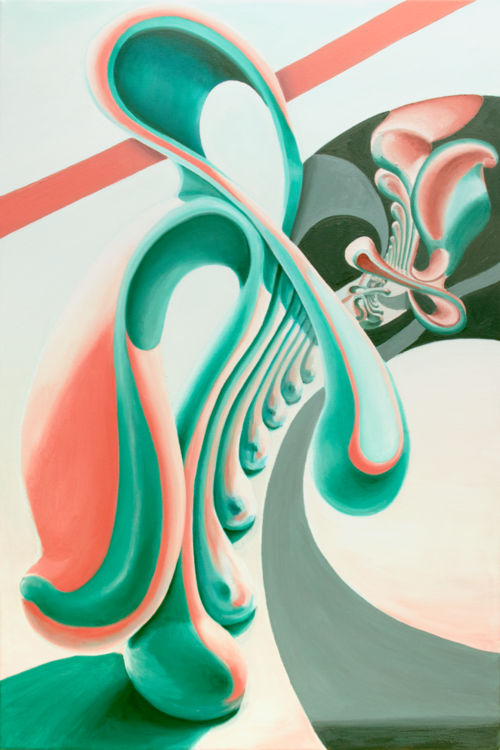
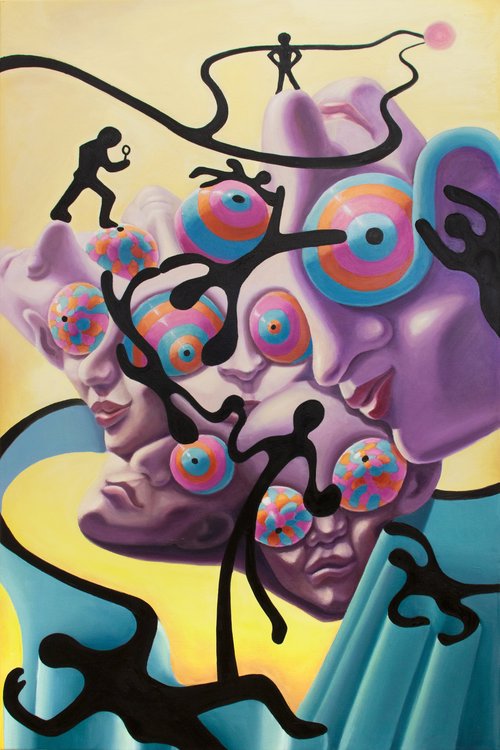
Some of Natalie's work. Shown here: 'Fractal Highway' and 'Gumdrop Mountaineers'
You've been practising for four years. So, how many of those years were you doing artistic development and how many years were business development?
The first two years, I was in school, and I was 100% fully involved in developing my style, developing skill sets, techniques, acquiring mentors, networking. So at least that and then maybe another year. So, three years, I'd say have been really development focused and I'm always going to be development focused. Process is very important for me, being contemporary and competitive is important to me. I always want to challenge myself and that's a very important part of my continual practice. This year, I started being more focused on business, learning more about marketing, promoting myself, creating products out of my artwork, and talking to people. Even just talking about my work has been very awkward from the beginning.
"I’m looking at people in my field who have established their practices, and looking at what they’re doing to create success for themselves."
Business skills don't always come naturally. How have you been developing yours?
I have no business background, nobody in my family did business, no network, nothing. So I studied with you in McMaster, we did sciences, I did Earth environmental sciences. And then I moved into fine arts later. And so, I never had that formal training for business. So for this year, I'm looking at role models. I'm looking at people in my field who have established their practices, and looking at what they're doing to create success for themselves.
Jane: What have you learned so far?
Natalie: So, if you want to be a very 'independent' artist... that’s the key, right? Because you could go the traditional route, and I might still try that as well. I want to try everything, and I want to make my dreams come true. I want this to be a lifelong career. Traditional art would be galleries. I want to see if I can do it independently, and how that would look like. So, what that looks like is: knowing how to market and how to use social media platforms to create a funnel into your business. And it could be generating leads, writing emails, and nurturing those relationships with people.
In-person was one of the best ways to show my work and engage with people. It's so awkward to show a photo of a piece of artwork and for a person to really resonate with it, especially with the competition that social media has. I've been learning how other artists are doing it, how they're marking up their images, how they're talking about their work, how they're choosing to create those ads, and marketing strategies. It's a lot to take in, especially somebody who's just kind of anxious about it, and learning for the first time in my life.
What kind of channels are you exploring, in terms of speaking to people who might be interested in your art? What have you found to be most effective for you?
Well, my personal network has been the most effective. Even four years ago, the networks I've made, the creative communities, they really like to support each other. It’s mostly been my network and then trying to reach followers who are similar. In-person interactions has been very effective. Once somebody meets you, they get that true impression of you. And you start to establish a relationship, a bond, and then you can continue that through social media. But if you're just meeting people through social media, there's still this distance between us, they don't get my vibe, they don't know who I am. It would be awesome if they just resonate with my work firsthand, and I can get people interested that way. But I found that in-person has been the most effective way for me, especially with me being so extroverted.
Jane: This is interesting, because most people are selling virtually or doing a lot of things online. But I never thought about this for people who are more extroverted. Do online interactions feel a bit more difficult for your compared to in-person markets?
Natalie: I would say it's also an experience, I'm still learning to navigate that right now. I love to talk to people in-person. In my practice, I'm not just seeking to sell my work and to make money. That's not my number one priority. I know, that's the number one priority of a business. But for me, the creative practice is to express myself and connect deeply to people. How can I do that through text and through social media? That's not easy. But you know, I'm learning so maybe I'll figure out how to do it better online next year.
I'm curious about how you define success. I want you to divide that into two sections. The first is the business side. The second is as an artist.
Success for me as an artist comes from within. If you don't love what you're doing and you're not creating wonder and magic within yourself while you're creating the work, then how are you going to pull through with a creative career? This is one of the hardest things to do and be financially successful. And so, you have to have a really deep meaning behind your work to push you forward. Success for me is about what I have learned, I look at the small things: if I've learned a new technique, or if I have come to a certain realisation or about elements, about aesthetic, about meaning, about relationships, in the artwork.
"If I have nobody to bounce my ideas and feedback off of, I'm not even sure if what I'm seeing and perceiving is what it should be. I need to have feedback from other people and another set of eyes to give me a different perspective, so that I can see the whole picture of what it is I am creating."
I have mentors, I have peers and I’m constantly speaking to them, generating feedback and making improvements in my work at the same time. That has just been a huge way for me to grow myself and my practice, and it's a system, and it's very necessary. If I have nobody to bounce my ideas and feedback off of, I'm not even sure if what I'm seeing and perceiving is what it should be. I need to have feedback from other people and another set of eyes to give me a different perspective, so that I can see the whole picture of what it is I am creating. So, this whole system of personal growth that I've been able to develop is incredibly satisfying, meaningful, and it is my way of feeling successful. It's just more from a spiritual perspective, and that is giving me my vitality that is pushing me forward in all of this. So that is the creative success that I've sculpted for myself, but the business success, it's separate. And at the beginning, it's small milestones. So, the first one was, can I even sell a piece? Just one piece. I wondered if anybody cared to buy a piece of my work to put it in their home. Does it even matter to them? That was two years ago. That's the kind of person I was, and I was so timid. I was so shy, I could not sell my work at that time. I was just like: maybe somebody will like it. It wasn't a priority to sell. But it was absolutely amazing idea. If something did sell, like it was just such a ‘whoa’ feeling. And so that was the milestone back then. Now, I'm pushing more in that domain, trying to understand what people like, why they like it, how people perceive things. I’m still trying to be authentic with my practice, but also just taking that information and just like: ‘oh, this is what people enjoy, maybe I'll do a little bit more of that, maybe I'll test this idea out’. It's just constantly prototyping, iterating, testing, and testing that market response.
Every time somebody buys something, I learned something new. And I get to improve my practice, and I just want to continue iterating until it gets better and better. It's not like a traditional business approach by any means. But it's the creative direction, and the creative part that is a priority to me.
Jane: What do you mean by traditional business approach? It sounds like what you're doing is what a business normally would do.
"...when I talk to more business-minded people, they always have a business plan and business strategy, and everything is just so structured, and it’s like: ‘oh, look at what your competitors are doing and do exactly that’. And that’s where I see red flags for me. Because I’m trying to differentiate myself."
Natalie: I guess so. But when I talk to more business-minded people, they always have a business plan and business strategy, and everything is just so structured, and it's like: ‘oh, look at what your competitors are doing and do exactly that’. And that's where I see red flags for me. Because I'm trying to differentiate myself.
I'm trying to be original and authentic. I liberate myself creatively, I opened myself up to something called freestyle drawing, automatism. So, I'm going in from my subconscious, my intuition to create concepts. If I started to think: ‘oh, I should do something like that artist’. Well then, now that seed has been planted for the conception of my work, that's dangerous for me in terms of authenticity and originality. I don't want to get caught up in those games. I don't want to copy anybody. I want to be creating my practice and growing it. Of course, I'm taking ideas from the world, but those are elements of execution in later stages, not the conception of ideas. So, in terms of traditional business, it's kind of scary when I think about looking at what this person is doing and then copy and make it better, because I want to do things originally, I want to do them differently. I want to be open to that.
Jane: The traditional business approach you’re referring to involves a lot of analysis. It’s important to start from the customers, ask them what they like and learn how to talk to them. And then from there, you can look at your competitors to understand what's good and what's not working. But, if you're being told to copy something, because it's done, and it looks like it will succeed, it doesn't mean those ideas will work for you.
Natalie: Yeah, customer feedback is important. And it's very easy to digest customer feedback if it's like about, let's say, maybe the size or the type of product. But if it starts to be about your style, about your aesthetic, then maybe you just don't like the style. But you need to know at a certain point where it's not generally appealing, and you need to get some aesthetic and creative growth. So, defining that line, and the boundaries and understanding the differences between the two is important.
Jane: Yeah, it’s about what's useful and what's not useful in terms of feedback.
Natalie: My aesthetic and my style is from me. I cannot control how people are going to receive it entirely. Different people have different responses and reactions. And that’s why I'm trying to find my niche audience. The only thing consistent here is me and my taste. That's the only thing I can work on and continue to develop. So, there's parts of it that I can't control and I just need to separate.
"I hope that I can share beautiful things with the world."
Why do you do what you do?
It's spiritually fulfilling. I feel that when I indulge in these practices, I have moments of clarity or realisations and moments of just awe and beauty and bliss. The practice the process is incredibly fulfilling, and I love that. I love engaging with it. I love having my community in my system to continue my personal development. But also, trying to create the greatest thing I can possibly create, for myself and to share. I hope that I can share beautiful things with the world. And these ideas just give me my vitality and reason for continuing.
Jane: Thank you so much for your time, Natalie.
Natalie: No problem.
Comments


